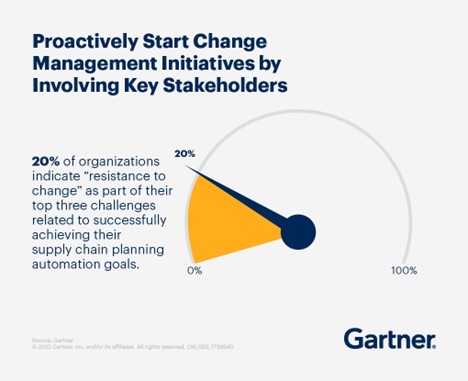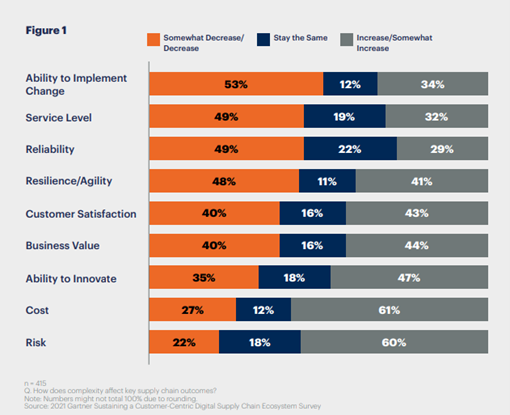Share this article
Follow us on Linkedin
While starting their supply chain planning transformation journey to implement SAP IBP, organizations have different levels of maturity, some could still be using excel files for their demand, supply or inventory planning while others can be operating on SAP APO or other legacy planning systems. Due to ever changing world and rapidly evolving challenges, it is imperative to explore inefficiencies or opportunities within your supply chain, some organizations relate to that and start on a digital transformation and their peers or competitors follow suit.
The objectives and visions of such transformations are usually defined by top management but often not communicated or adapted (top-down) along the organization structure. It’s quite easy to build a best-in-class SAP IBP system with the industry leading processes and then ask people to just follow suit but it doesn’t quite work that way, does it? Generally, people don’t like being told what to do, at least I wouldn’t. If I am forced to eat the tastiest curry even if it is prepared using best ingredients and in the most hygienic way, make it extra spicy and I still wouldn’t.
According to Gartner, 20% of organizations indicate resistance to change as one of the top three challenges for supply chain planning:
(Sources: Gartner)
Some of the key challenges for digital transformation for supply chain planning:
- AS-IS business processes can be irrelevant considering they were framed ages ago. Geopolitical tensions, logistic issues, pandemics, AI etc make these processes inefficient or obsolete
- Siloed business processes, for example S&OP (Sales & Operations Planning) and short-term planning working in silos rather than collaboratively we all want to, that’s one of the most common visions we’ve heard from customers
- Inability to let go of control. We obviously do not want a chaotic demand or supply plan but not letting go of some things can be the real source of inefficiencies
… and many more (I’m wondering if you’ve already identified fourth in your organisation). But the most unacknowledged of them all is change management (now, again read from bullet points 1 to 4 (we need to talk now if its more than 4 already 😊) and see if you insert a slice of change management, I’m sure things start to unravel, and problems become less complex.
According to Gartner, supply chain complexity is constantly growing, impacting costs, risk, reliability, service level, customer satisfaction and the ability to implement change:
(Sources: Gartner)
Considering the world has moved on from the practicalities of the times since you last implemented a supply chain planning solution, it’s high time to re-examine processes and/or systems with a different point of view. Some of the reason(s) to consider change management for supply chain planning:
- Challenges in S&OP and strategic planning have changed drastically compared to few years ago (if not decades), for example while finalizing your sales and operational plans for medium to long term you might need to adjust the plans or build contingencies & resilience in your plans as pandemic might be over (but you’re never far away from another) or semiconductor crisis might have resolved but you never know when another raw material supply might give in.
- Adaptability and resilience in short term planning has never been as crucial as ever. We now live in times when you can order supplies to be delivered same day at your fingertips or worse cancel or modify the orders on a whim. So, the processes, systems and architectures built in years gone by are becoming more redundant by the day. To incorporate that we need to adapt and get used to CHANGE while implementing short term planning solutions.
- New technologies also bring the challenge of new or different roles and responsibilities e.g. Machine Learning algorithms can help provide better planning results in a more automatized way, but you also need people in the organization that can understand how ML tools work and are able to identify when and how the parameters of these algorithms can be changed if the demand drivers in the market change.
The list can go on and on and some reasons might be industry or customer specific or carry more importance from one company or person to another, but then the question arises how to adapt or prepare yourself to process change.
During a supply chain planning transformation programme, emphasis is most often than not on implementing best in class software (such as SAP IBP) along with cutting edge technologies like Artificial Intelligence & Machine Learning. However, what lags is people and the need for change management. People often think change management equals training management (or even change request management) but believe me it’s not just training and enablement, it’s much more than that. This is why we should specify it a little more and talk about Organizational Change Management (OCM). OCM is a systematic and structured approach that empowers organizations to navigate transitions effectively. Utilizing a flexible set of methods, tools and templates, OCM enables stakeholders to identify, plan, and execute activities to achieve the desired future state of the organization. This includes fostering the necessary mindsets, behaviours and skills required to sustainably implement the target vision.
So, for IBP projects the real challenge lies with adapting or reimagining processes and taking all the associated people on the journey along the way to make the vision a reality not just on paper but also in day-to-day work life of those people. (Talking about vision: Please think about your recent projects, how many of them even have a real documented and communicated project vision?)
Organizational Change Management is crucial for successful transformation projects. Here are some reasons why it’s essential:
- Stakeholder Engagement: OCM ensures that key stakeholders are involved and informed throughout the project. Their buy-in and support are critical for successful implementation.
- Behavioural Shifts: Transformation projects often require employees to adopt new processes, tools, or ways of working. OCM helps manage this behavioural change by addressing resistance and promoting acceptance.
- Communication: Effective communication is central to any transformation. OCM develops communication plans, ensuring consistent messaging and transparency.
- Training and Skill Development: OCM identifies training needs and provides relevant training programs. This helps employees build the skills required for the new processes.
- Risk Mitigation: OCM assesses risks related to change and develops mitigation strategies. It helps anticipate challenges and address them proactively.
Remember, OCM isn’t just about processes; it’s about people. By focusing on their needs, concerns, and readiness, organizations can navigate transformations successfully.
Some of the renowned change management models which can be used for transformation projects are:
- Prosci ADKAR model, which focusses on individual changes while guiding people through a change. It’s based on five outcomes an individual needs to achieve for a change to be successful – Awareness, Desire, Knowledge, Ability and Reinforcement:
- John Kotter’s 8 steps to accelerate change in your organizations by creating urgency, forming a vision, getting the right people, and removing barriers. It also highlights the benefits of short-term wins and then sustaining that with accelerated and continuous change.
- Lewin’s 3 step change model into 3 steps – Unfreeze (what needs to change), change (implement the change) & refreeze (review and stop going back to old ways).
WE at Westernacher developed our own approach for OCM and have always championed that in most successful digital transformations, the cornerstone has been PEOPLE. It’s the people who make the difference. That’s why we always recommend focussing 30% on SAP IBP as a tool but 70% on people and processes (that’s where change management comes in) because it’s ultimately those people who will be using SAP IBP not the other way around.
References:
Prosci, Kotter Inc, Gartner


